News Readers Reading From Screen in Front
Have you ever wondered how news anchors and television receiver reporters evangelize information seamlessly on camera? It's all thanks to the teleprompter. These brandish devices enable a presenter to read from a prepared script or spoken language while maintaining middle contact with the photographic camera at all times. This gives viewers the impression that the presenter has memorized a spoken language or is speaking spontaneously since they don't accept to look downward or to the side, which is usually the case when reading from a written document or cue cards.
Television receiver presenters, world leaders, and public speakers regularly employ teleprompters to communicate their bulletin without having to glance downward at written notes. This enables them to build a stronger rapport with their audience past maintaining natural eye contact throughout the speech communication.
Recently, the use of teleprompters has broadened to include scripted video product and slideshow presentations. Vocalists as well use teleprompters to assistance them recall lyrics while performing on stage.
So how does a teleprompter work?
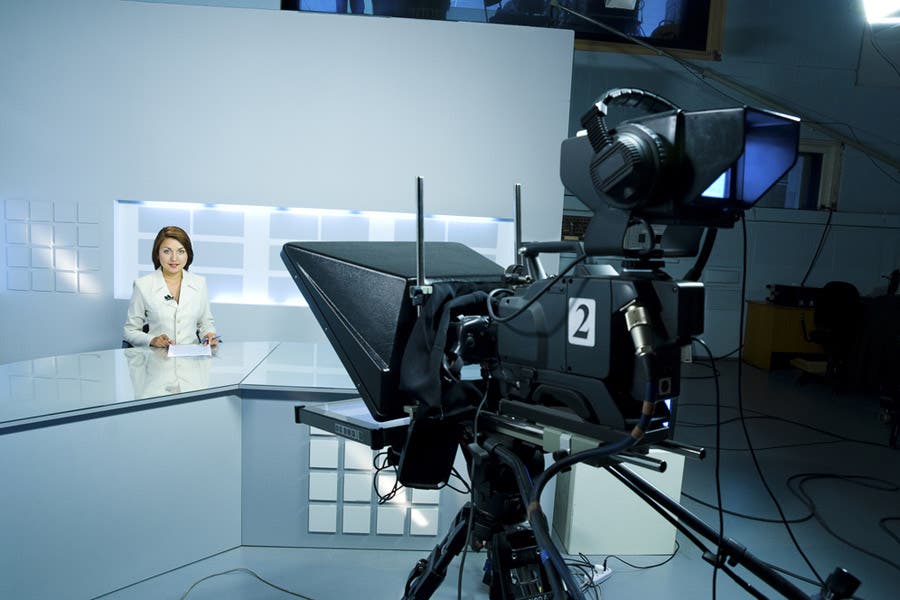
A teleprompter comes with a reflective screen that is typically placed in forepart of the video photographic camera lens, every bit well every bit a monitor, mounted direct underneath the screen, that displays the script.
The screen is made of cogitating glass or an optical beam splitter and is completely run into-through on one side and reflective on the other. This allows the photographic camera to shoot through it without visually affecting the video. Meanwhile, the other side of the screen (the side that faces the presenter) is reflective, so anything that is displayed on the monitor underneath volition be reflected onto the screen.
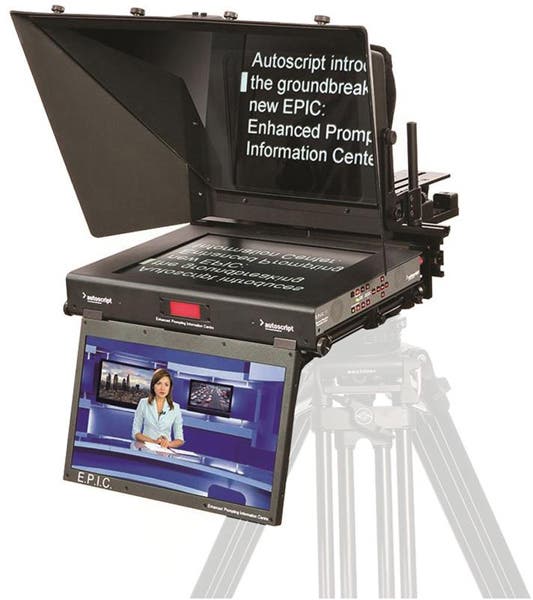
However, in the same way that anything you meet in a mirror is flipped horizontally, the image on the monitor would also be backwards on the screen. Therefore, the script must be reversed on the monitor so that when it'south reflected in the glass, the presenter will be able to come across it the right style.
In major productions or broadcasts, the teleprompter is unremarkably operated by a coiffure fellow member, who adjusts the format, scrolling speed, and management of the text every bit it appears on the teleprompter screen and ensures a comfortable pace to make it easy for the presenter to read the script seamlessly. The operator has to pay attention to what the presenter is saying so they can follow the latter's pacing instead of forcing them to speak at a speed that they are not comfortable with. If in that location is no operator during the shoot, the presenter can use a wireless controller or a human foot pedal to command the scrolling speed.
In addition to the fundamental principle of displaying text on a screen, newer teleprompters likewise give y'all control over your device past letting you jump to other parts of your script, fifty-fifty though multiple presenters are currently on the broadcast.
What are the different types of teleprompters?
In that location are three common types of mod teleprompters: photographic camera-mounted, floor or standing, and "Presidential" or podium.
Photographic camera-mounted teleprompters projection your script directly onto the camera, which means you'll be looking straight at the camera lens when speaking. Floor or continuing teleprompters are mounted at an angle on the floor, which means you may end up looking down too much, causing you to constantly break heart contact with your audience.
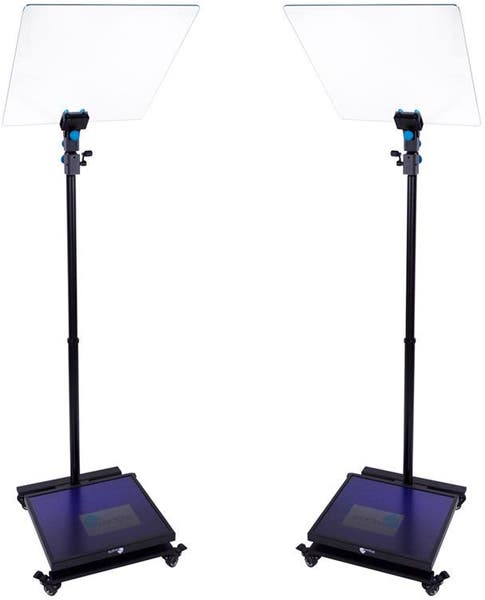
Presidential or podium teleprompters are and so named considering of the fact that they are the preferred prompting devices of US Presidents like Barack Obama. They work the same fashion every bit photographic camera-mounted systems, except that they aren't mounted to a photographic camera. Instead, these are standalone devices with up-facing flooring monitors, adjustable stands, and glass screens that are tilted at a slight angle and positioned at eye level, making them perfect for speaking from a podium.
Near of these prompting systems normally come in pairs—like the MagiCue Presidential xix″ Stage Master Prompter Package ()—then that ane can exist placed on either side of the speaker. Each i has a glass screen at the top, which displays mirrored text from the monitor located at the base of operations of the stand up. The screens are essentially "one-way" mirrors, so that while the speaker sees the text projected on the reflective drinking glass surface, the audience merely sees what appears to be tinted glass.
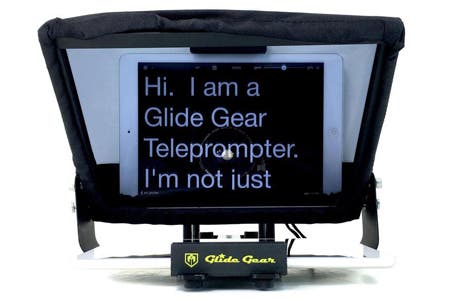
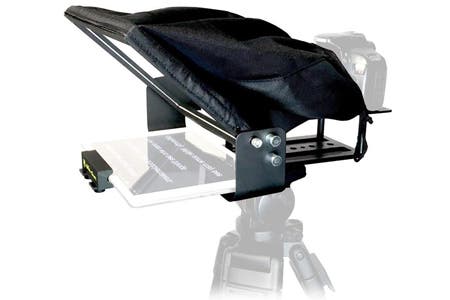
Mobile teleprompters have also grown in popularity in recent years, peculiarly when filming outside of the studio. Teleprompting systems like the iKan Elite iPad Teleprompter Kit () or the Glide Gear TMP 100 Video Teleprompter for iPad & Smartphone () allow users to load or type their script into a teleprompting app on their iPad (or other compatible mobile devices). The latter is and then mounted to the organization in lieu of a dedicated teleprompter monitor.
Pros and cons of using a teleprompter
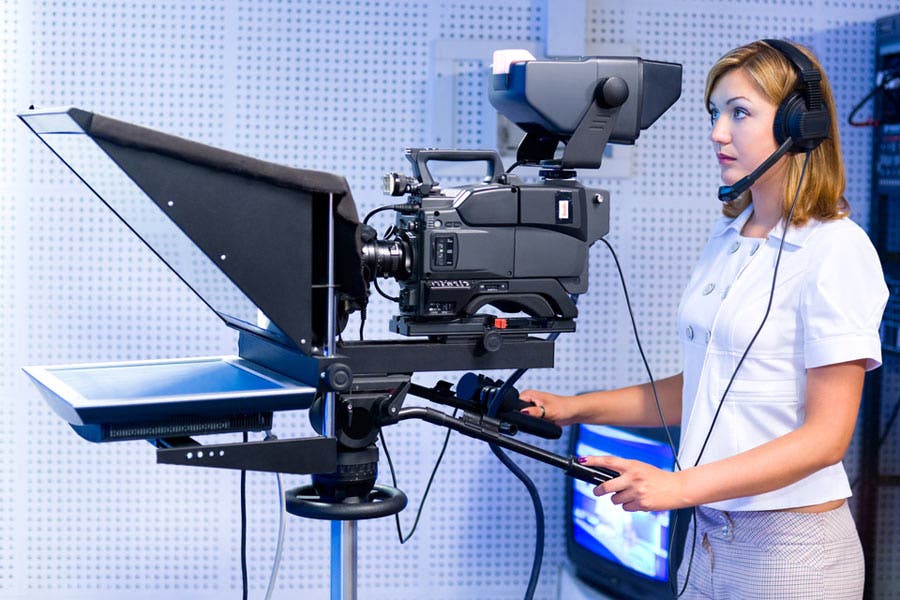
Having a teleprompter on-set gives yous and your production team numerous benefits. Commencement, the device doesn't oblige presenters to evangelize their lines from retention, helping them maintain their composure in front of the camera. Hosts and news anchors can focus on existence charming and professional, while consistently maintaining eye contact with their viewers or audience.
Second, with the aid of a teleprompter, presenters will commit fewer mistakes and avoid using filler words while speaking. This helps shorten product fourth dimension and minimize costs, as the presentation can be recorded with fewer takes—which is one of the reasons why budding YouTube content creators should consider calculation teleprompters to their must-have video equipment list.
During live gatherings and conferences, teleprompters tin help you stay on-topic and avert going over the time limit allotted to you. Having your spoken communication projected on the prompter can likewise keep you from making glaring repetitions and ensure that detailed information, such as technical specifications and business organisation figures, are presented accurately.
On the other paw, working with a teleprompter during shoots has its drawbacks. If you're the presenter, you'll have to rehearse your lines beforehand in society to audio natural in front end of the camera. It ofttimes takes immense exercise to sound like you lot're speaking naturally rather than reading off of a teleprompter. Moreover, as teleprompters tin but display a few lines of the script at a fourth dimension, you'll demand to mentally conceptualize the next few lines while you're talking.
And if yous're reading off a screen in front of you during a shoot, your optics will be moving back and forth. If you're positioned too close to the teleprompter, viewers will be able to tell that you're reading a script.
Although it may accept plenty of rehearsing and training before you can go the hang of using a teleprompter, once mastered, information technology will enable you to take control of your presentation and captivate your audience.
Origins of the Teleprompter
The teleprompter has its origins in the mail-state of war period. While moving picture actors were oftentimes given weeks or months to memorize their lines, television actors sometimes had merely days or hours to do the same. Following the rise of live television, people in the industry realized that a device was needed to help actors call up their lines during shoots. Cue cards were sometimes used to help actors, only relying on ungainly stagehands to flip these cards often led to awkward delays.
In 1948, an executive at 20th Century Fox Studios asked Hubert Schlafly, an electrical engineer, if cue cards could be connected in a motorized scroll, giving actors their much-needed prompts. Using half of a suitcase as the outer beat, Schlafly fashioned a device equipped with belts, pulleys, and a motor to plough a ringlet made of butcher paper. The actor's lines were written on the scroll in large messages—about half an inch in height. In 1949, he patented the device and named it the "TelePrompTer" in honor of the stagehands who helped actors remember their lines.
Since these humble beginnings, the teleprompter has go much more than sophisticated in terms of its construction and capabilities, and it remains a staple piece of equipment in live broadcasts and other of import productions. While initially invented for television actors, it has go an essential tool for news anchors, politicians, religious leaders, and anyone who has to recite speeches and scripts seamlessly in front end of a alive audition.
Source: https://www.adorama.com/alc/how-teleprompters-work/#:~:text=Have%20you%20ever%20wondered%20how,the%20camera%20at%20all%20times.

0 Response to "News Readers Reading From Screen in Front"
Post a Comment